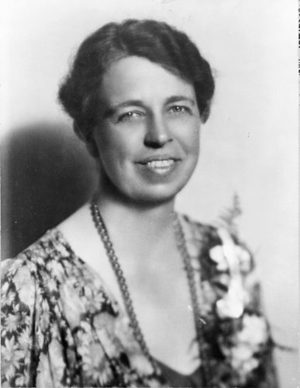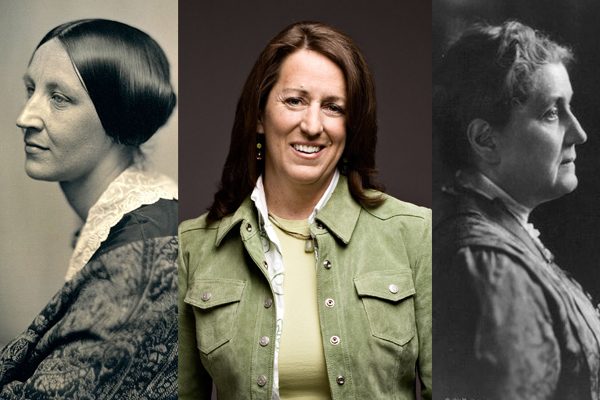Lesbians have played a major role throughout American history in the charge toward social equity.
If you Google “famous lesbians,” and you are, like me, an historian or a student of history, you’ll be quite disappointed. Site after site reads like the credits for The L Word–every actress ever on the series and her mother (such as Clementine Ford and Cybill Shepherd), lesbian or not, is on these lists. The other listees are perennial favorites: Ellen DeGeneres, Melissa Etheridge and Rosie O’Donnell.
In 2010, “famous lesbians” is synonymous with “celebrity lesbians” or “lesbians on TV,” rather than meaning the founding mothers who altered American history, like Susan B. Anthony, Lucretia Mott, Sojourner Truth, Elizabeth and Emily Blackwell, Jane Addams, Alice Hamilton, Emma Goldman, Eleanor Roosevelt and a host of other pioneering women whose quest for social justice saved and changed lives.
Why are the prodigious achievements of these women, our lesbian foremothers, so eclipsed? After all, they formed the radical reformist foundation for the 20th century–and thus our own current public policy. They are the women who changed America by literally inventing a social justice movement that would touch nearly every aspect of modern American life. That social justice movement focused on social welfare, and would later become incorporated into both the federal government and the private sector in the form of agencies that would foment and support social justice for all Americans, but especially the most vulnerable and marginalized–women, children, immigrants, people of color, the sick, the uneducated and the poor.
It began with abolition. Women were the backbone of the abolitionist/anti-slavery movement.
Abolition and suffrage became synchronized movements for many women. Susan B. Anthony, an abolitionist leader, was one of the founders of the first wave of American feminism (along with Elizabeth Cady Stan. At 16, she was collecting anti-slavery petitions. Not many years after, she wrote her first treatise on women’s suffrage, noting, “Universal manhood suffrage, by establishing an aristocracy of sex, imposes upon the women of this nation a more absolute and cruel despotism than monarchy; in that, woman finds a political master in her father, husband, brother, son. The aristocracies of the old world are based upon birth, wealth, refinement, education, nobility, brave deeds of chivalry; in this nation, on sex alone; exalting brute force above moral power, vice above virtue, ignorance above education, and the son above the mother who bore him.”
Thus feminism’s first wave was born.
Anthony worked tirelessly for the rights of women and to free blacks from slavery. Her efforts to unify the black and women’s suffrage movements brought attention to both movements and tensions within the suffrage movement.
Historians differ on whether Anthony was a lesbian, but her deepest relationships were with other women and she never married. She was said to have been the “third person” in the marriage of Elizabeth Cady Stanton, her longtime companion with whom she traveled for three decades giving speeches. Anthony’s feminism and quest for equal rights for women and blacks was the first plank in the platform women were building for social justice in America.
Anthony and Stanton were models for social activism by women and others soon followed in their ground-breaking footsteps.
There has been no more vital and decisive advocate of social justice in American history than Jane Addams.
Addams is, after Benjamin Franklin, the American who has most influenced modern American life.
Addams was a lesbian and lived in two different Boston marriages for her entire adult life, first with Emily Gates Starr and then for decades with Mary Rozet Smith. Some historians insist on referring to these relationships as “romantic friendships,” but as modern lesbians know, lesbian relationships and romantic friendships are often synonymous.
The range of Addams’ accomplishments is prodigious: she co-founded the Settlement Movement in America, which is now considered the foundation for modern social work. She co-founded the ACLU (American Civil Liberties Union). She co-founded the Women’s International League for Peace and Freedom (WILPF), still a thriving social justice organization which today subsidizes women’s peace work worldwide. She helped convene the Washington, D.C. meeting in 1915 that resulted in the founding of the Woman’s Peace Party, the first national women’s peace organization in the United States, and was elected its first president. She was the first American woman to win the Nobel Peace Prize.
Addams put her own life’s work in perspective when she said, “Action indeed is the sole medium of expression for ethics.”

That quote is defining, because it would be difficult to over-estimate the impact of Addams as a reformer. Hull House, which she co-founded in Chicago with Starr and which was initially funded with an inheritance she received, became the prototype for social services agencies today.
Simply put, Addams wanted to help women and the poor. She was particularly concerned about educating immigrant women and saving the lives of women and children which were under immense threat from poverty and disease. Hull House bordered several ethnic and immigrant neighborhoods in downtown Chicago.
The breadth of Addams’ plan was as impressive as it was expansive, particularly when you consider that Hull House was her invention. Hull House served about 2,000 people a week. It was both school and social services agency, as well as home to more than 25 women, plus Addams and Starr and later Smith.
Among the services provided were a night school for adults which focused on English classes for immigrants, kindergarten classes, clubs for older children to keep them off the streets and out of trouble, a girl’s club and a gym. There was a book bindery to teach a trade, a drama group, a music school with a variety of instruments, an art gallery and a massive library.
Since poverty was such a serious issue, Addams provided a public kitchen, a coffeehouse and a bathhouse because many in the neighborhood had no access to bathing. She and Starr also served as midwives and nurses to the surrounding population and they took in abandoned children for placement.
Hull House also had services that address labor-related issues for adults in the area, since the majority were factory workers. Hull House eventually expanded to 13 buildings and incorporated a thriving night school for women.
The impact of Hull House and Addams’ work there was phenomenal. She drew women from all over the country and the world who wanted to train as social workers under her tutelage. Hull House was the proving ground for many great social activists, like Florence Kelley, a fierce advocate of the rights of workers, opponent of child labor and who herself would later co-founded the National Child Labor Committee and wo the NAACP.
Another social activist drawn by Addams to Hull House was Dr. Alice Hamilton, whose dedication (some said Hamilton was in love with Addams and there were conflicts with Smith when Hamilton moved into Hull House) to Addams led her to found her own movement within the social justice orbit–occupational medicine.
Hamilton’s work is responsible for occupational safety in the workplace today. Initially Hamilton took the work of Hull House into the tenements of Chicago, making house. As she did, Hamilton began to uncover a host of occupation-related illnesses and injuries, among them poisoning that women milliners got from mercury used in making hats, phosphorous poisoning that women got from working in match factories and men got from working in munitions factories and numerous on-the-job injuries that were never compensated. She worked to get worker’s compensation for the injured and sick.
Hamilton would become the first woman on the faculty at Harvard as well as the first to head the newly founded (at her urging) office of Occupational Safety and Hazard (OSHA), but being in the vanguard had been an immense struggle for her and the response from male colleagues had been a combination of scepticism and scorn. She noted, “When I talked to my medical friends about the strange silence on this subject [occupational hazards for workers] in American medical magazines and textbooks, I gained the impression that here was a subject tainted with Socialism or with feminine sentimentality for the poor.”

All her work had devolved from her association with Addams and Hull House and she said the connection had been the definitive one in her life. “Everything I learned [from Addams] was new and almost all of it valuable.”
The influence of these reformers was felt by other women. Eleanor Roosevelt certainly had been influenced by Addams and mentioned her often in her writings and speeches as an American icon.
Roosevelt, who had a long lesbian affair with the journalist Lorena Hickok, was herself a reformer, using her role as First Lady to focus on social justice issues. She had an immense personal influence on beginning the national and legal conversation about desegregration by forcing the issue at the White House. Roosevelt insisted on inviting African Americans to state dinners and it was she who arranged the concert for Marian Anderson, which is now legendary.

Her work with women’s rights, the rights of children and the rights of the disabled was also iconic, but it was her fierce campaign against racism that had the most influence of all her social justice efforts.

In recent decades lesbians have also led movements for social justice. Barbara Jordan began as a civil rights worker and ended up in Congress where her efforts at reform were legendary.
Dr. Susan Love brought worldwide attention to the threat breast cancer posed for all women and the high incidence of the disease among lesbians.
Roberta Hacker founded the first services for lesbian victims of domestic violence in domestic violence agencies.
Through her agency, National Center for Lesbian Rights (NCLR), Kate Kendall developed a specific platform for lesbian legal issues, like child custody and marriage, citing the distinctions between the issues gay men face and those for lesbians.
Rev. Irene Monroe, of Harvard Divinity School, brought homophobia in the black community and racism in the queer community to the forefront in her radical writings on theology, racism and homophobia which have been disseminated worldwide.
Mandy Carter was on the list of nominees for the Nobel Peace Prize in 2008 after decades of work in the feminist, lesbian and black civil rights movements.
The pioneering lesbians who founded social justice movements in America have been given short shrift historically. Not just by men, but by our own community. The insistence on referencing “romantic friendships” as if lesbian sexuality did not exist prior to Stonewall is a homophobic anachronism that needs to be debunked. But more importantly, our own community is under threat of forgetting or simply ignoring the historical import of these truly great lesbians because of our focus on lesbian celebrity in the here and now.
The “L-word” of a century ago was love for women and the concomitant fight for women’s lives. Many lesbians are continuing that fight today, and those women may be in tomorrow’s history books. But for now, the founding mothers of social justice in America are fading into the historical background when they deserve to be in the foreground. Without them, many of the services that women depend on today would not exist. Social justice wasn’t invented by lesbians, but in America, it was led and fought for by lesbians. That’s history of which we should be monumentally proud and these are women we must never forget.
As Jane Addams noted, “Nothing could be worse than the fear that one had given up too soon, and left one unexpended effort that might have saved the world.” That is social justice in action, the legacy our lesbian foremothers have left us.
